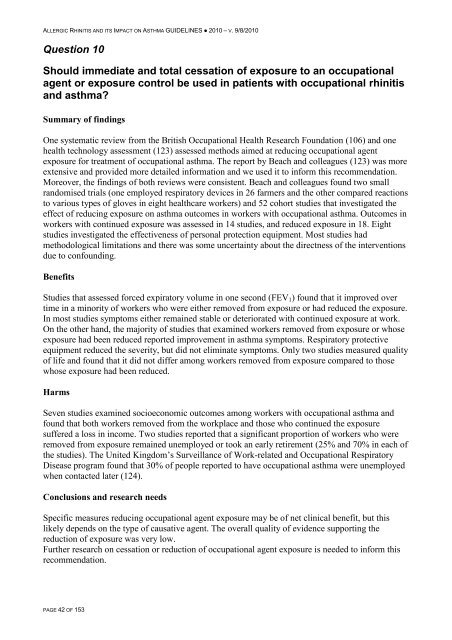Allergic Rhinitis and its Impact on Asthma - ARIA
Allergic Rhinitis and its Impact on Asthma - ARIA
Allergic Rhinitis and its Impact on Asthma - ARIA
Create successful ePaper yourself
Turn your PDF publications into a flip-book with our unique Google optimized e-Paper software.
ALLERGIC RHINITIS AND ITS IMPACT ON ASTHMA GUIDELINES ● 2010 – V. 9/8/2010<br />
Questi<strong>on</strong> 10<br />
Should immediate <str<strong>on</strong>g>and</str<strong>on</strong>g> total cessati<strong>on</strong> of exposure to an occupati<strong>on</strong>al<br />
agent or exposure c<strong>on</strong>trol be used in patients with occupati<strong>on</strong>al rhinitis<br />
<str<strong>on</strong>g>and</str<strong>on</strong>g> asthma?<br />
Summary of findings<br />
One systematic review from the British Occupati<strong>on</strong>al Health Research Foundati<strong>on</strong> (106) <str<strong>on</strong>g>and</str<strong>on</strong>g> <strong>on</strong>e<br />
health technology assessment (123) assessed methods aimed at reducing occupati<strong>on</strong>al agent<br />
exposure for treatment of occupati<strong>on</strong>al asthma. The report by Beach <str<strong>on</strong>g>and</str<strong>on</strong>g> colleagues (123) was more<br />
extensive <str<strong>on</strong>g>and</str<strong>on</strong>g> provided more detailed informati<strong>on</strong> <str<strong>on</strong>g>and</str<strong>on</strong>g> we used it to inform this recommendati<strong>on</strong>.<br />
Moreover, the findings of both reviews were c<strong>on</strong>sistent. Beach <str<strong>on</strong>g>and</str<strong>on</strong>g> colleagues found two small<br />
r<str<strong>on</strong>g>and</str<strong>on</strong>g>omised trials (<strong>on</strong>e employed respiratory devices in 26 farmers <str<strong>on</strong>g>and</str<strong>on</strong>g> the other compared reacti<strong>on</strong>s<br />
to various types of gloves in eight healthcare workers) <str<strong>on</strong>g>and</str<strong>on</strong>g> 52 cohort studies that investigated the<br />
effect of reducing exposure <strong>on</strong> asthma outcomes in workers with occupati<strong>on</strong>al asthma. Outcomes in<br />
workers with c<strong>on</strong>tinued exposure was assessed in 14 studies, <str<strong>on</strong>g>and</str<strong>on</strong>g> reduced exposure in 18. Eight<br />
studies investigated the effectiveness of pers<strong>on</strong>al protecti<strong>on</strong> equipment. Most studies had<br />
methodological limitati<strong>on</strong>s <str<strong>on</strong>g>and</str<strong>on</strong>g> there was some uncertainty about the directness of the interventi<strong>on</strong>s<br />
due to c<strong>on</strong>founding.<br />
Benef<str<strong>on</strong>g>its</str<strong>on</strong>g><br />
Studies that assessed forced expiratory volume in <strong>on</strong>e sec<strong>on</strong>d (FEV1) found that it improved over<br />
time in a minority of workers who were either removed from exposure or had reduced the exposure.<br />
In most studies symptoms either remained stable or deteriorated with c<strong>on</strong>tinued exposure at work.<br />
On the other h<str<strong>on</strong>g>and</str<strong>on</strong>g>, the majority of studies that examined workers removed from exposure or whose<br />
exposure had been reduced reported improvement in asthma symptoms. Respiratory protective<br />
equipment reduced the severity, but did not eliminate symptoms. Only two studies measured quality<br />
of life <str<strong>on</strong>g>and</str<strong>on</strong>g> found that it did not differ am<strong>on</strong>g workers removed from exposure compared to those<br />
whose exposure had been reduced.<br />
Harms<br />
Seven studies examined socioec<strong>on</strong>omic outcomes am<strong>on</strong>g workers with occupati<strong>on</strong>al asthma <str<strong>on</strong>g>and</str<strong>on</strong>g><br />
found that both workers removed from the workplace <str<strong>on</strong>g>and</str<strong>on</strong>g> those who c<strong>on</strong>tinued the exposure<br />
suffered a loss in income. Two studies reported that a significant proporti<strong>on</strong> of workers who were<br />
removed from exposure remained unemployed or took an early retirement (25% <str<strong>on</strong>g>and</str<strong>on</strong>g> 70% in each of<br />
the studies). The United Kingdom’s Surveillance of Work-related <str<strong>on</strong>g>and</str<strong>on</strong>g> Occupati<strong>on</strong>al Respiratory<br />
Disease program found that 30% of people reported to have occupati<strong>on</strong>al asthma were unemployed<br />
when c<strong>on</strong>tacted later (124).<br />
C<strong>on</strong>clusi<strong>on</strong>s <str<strong>on</strong>g>and</str<strong>on</strong>g> research needs<br />
Specific measures reducing occupati<strong>on</strong>al agent exposure may be of net clinical benefit, but this<br />
likely depends <strong>on</strong> the type of causative agent. The overall quality of evidence supporting the<br />
reducti<strong>on</strong> of exposure was very low.<br />
Further research <strong>on</strong> cessati<strong>on</strong> or reducti<strong>on</strong> of occupati<strong>on</strong>al agent exposure is needed to inform this<br />
recommendati<strong>on</strong>.<br />
PAGE 42 OF 153


